Philip K. Dickathon: Dr. Bloodmoney
Guest Blogger and WWEnd Member, Charles Dee Mitchell, has contributed a great many book reviews to WWEnd and we’ve invited him to contribute to our blog. This is the latest in Dee’s series of Philip K. Dick reviews that he started on his blog www.potatoweather.blogspot.com. We’ll be posting one every week until he runs out of reviews or gets tired of Philip K. Dick books.
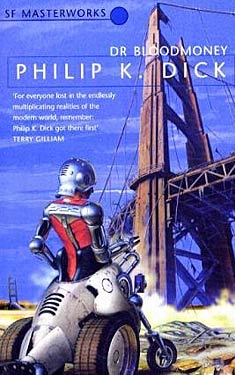 Thank God for editors. PKD proposed two titles for this post-nuclear apocalypse novel: In Earth’s Diurnal Course and A Terran Odyssey. Donald Wolheim at Ace came up with Dr. Bloodmoney: or How We Got Along After the Bomb. Wolheim’s title might have been a flagrant effort to cash in on Stanley Kubrick’s Dr. Strangelove: or How I Learned to Stop Worrying and Love the Bomb, but at least it did not include the word "diurnal," and it did give some hint to what the book is about.
Thank God for editors. PKD proposed two titles for this post-nuclear apocalypse novel: In Earth’s Diurnal Course and A Terran Odyssey. Donald Wolheim at Ace came up with Dr. Bloodmoney: or How We Got Along After the Bomb. Wolheim’s title might have been a flagrant effort to cash in on Stanley Kubrick’s Dr. Strangelove: or How I Learned to Stop Worrying and Love the Bomb, but at least it did not include the word "diurnal," and it did give some hint to what the book is about.
This is one of the dozen or so novels PKD wrote in 1963/64, but due to the build up of back inventory, it was not published until 1965. It is surprisingly idyllic given the subject matter and the amount of amphetamines the author was ingesting at the time. There had been two post-nuclear bestsellers in the late 1950’s, Pat Frank’s Alas, Babylon — still, I understand, a favorite for middle school book reports — and Neville Shute’s On the Beach, which as both a novel and film seemed determined to prove just how tedious it would be to wait for death from radiation poisoning. PKD gets in a sly dig at the latter in his own novel. Walt Dangerfield, a would-be Martian colonist stuck in eternal earth orbit, broadcasts music and readings for survivors on Earth. One of their most requested songs is Waltzing Matilda, the traditional Australian ballad that served as theme music to On the Beach.
As is his habit, PKD has little interest in what might be the actual effects of an atomic war. His characters go about their lives in Marin County pretty much as they would pre-holocaust. They hold town meetings, they have affairs, they gather mushrooms. They have a resident psychiatrist. They mostly walk or ride bicycles rather than use wood-burning or horse-drawn automobiles. As a community they are insular and suspicious of outsiders, but they should be since jealous outsiders might want to "nap" some vestiges of the good life they maintain. They are also blessed with the best handyman around, Hoppy Harrington, a "phoce," a diminutive for phocomel, those with a congenital deformity that produces flipper-like arms and legs. But Hoppy more than makes up for his shortcomings with his mobile machine and some very special powers. In an early scene, he fixes a turntable by healing it. He gets more dangerous later on.
I just finished this book yesterday, and I am trying to remember if it has a plot. I don’t think it does. It really is a sort of pastoral — with mutants. Rats have learned to play the nose-flute. Cats have developed their own secret language, and dogs make a pitiful attempt at speaking English. By the novel’s end, mail routes are opening again, and some of the characters feel the lure of the big city. They plan to go into the cigarette manufacturing business.
Philip K. Dickathon: We Can Build You
Guest Blogger and WWEnd Member, Charles Dee Mitchell, has contributed a great many book reviews to WWEnd and we’ve invited him to contribute to our blog. This is the latest in Dee’s series of Philip K. Dick reviews that he started on his blog www.potatoweather.blogspot.com. We’ll be posting one every week until he runs out of reviews or gets tired of Philip K. Dick books.
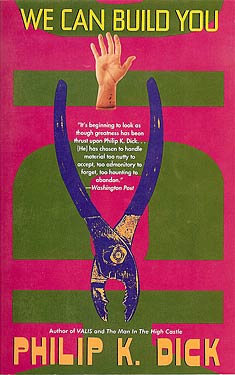 Philip K. Dick always said that he wrote with his fingers. For a decade or so he wrote with his fingers on speed. He would get an outline together, then sit himself at the typewriter and let it flow. He wrote We Can Build You in 1962, his annus mirabilis during which he completed 12 novels. This is the most "stream of conscious" novel of his that I have read. Not in the sense that he is creating characters who share their interior monologues. The interior monologue is all Phil’s, partially put into the mind of his first person narrator, but mostly spilling out in a direct current from his brain to his fingers to the page.
Philip K. Dick always said that he wrote with his fingers. For a decade or so he wrote with his fingers on speed. He would get an outline together, then sit himself at the typewriter and let it flow. He wrote We Can Build You in 1962, his annus mirabilis during which he completed 12 novels. This is the most "stream of conscious" novel of his that I have read. Not in the sense that he is creating characters who share their interior monologues. The interior monologue is all Phil’s, partially put into the mind of his first person narrator, but mostly spilling out in a direct current from his brain to his fingers to the page.
We Can Build You takes place in the distant future of the 1980’s. (PKD seldom bothered setting stories far enough into the future that any of the scientific marvels he works into his plots might be even vaguely possible.) Louis Rosen works for Maury Rock in a shady sales business. They run ads in small-town newspapers announcing the local repossession of a piano or electronic organ, and they are ready to make a deal if it saves shipping. They do pretty well, having survived one Better Business Bureau investigation, but business is drying up. Maury and his engineer have decided instead to go into the simulacra business, creating human simulacra so lifelike they easily pass as the real McCoy, or in this case the real Edwin M. Stanton, Abraham Lincoln’s Secretary of State. They have Lincoln himself in the works.
One quarter of the American population is schizophrenic and spends time in government-run facilities. A small number of citizens are radiation mutants — Louis’s younger brother has his face upside down on his head. Thomas C. Barrow is an entrepreneur who needs to unload some lunar real estate. Pris is a beautiful, recovering schizophrenic and Maury’s daughter. Louis’s love of Pris is driving him insane.
That’s about it. Scene after scene is outrageous but seldom very funny. Perhaps because the narrator is so driven, there is never any distance from the action. Take a scene where Louis is getting legal advice from Abraham Lincoln in a San Francisco nightclub while Earl Grant performs onstage. That’s funny when you think about it.
I can imagine some French critic has described We Can Build You as a meditation on what it means to be human, which I suppose it is. But I have a different idea. Think of it as a ride on a roller coaster that consists of nothing but that first, breathtaking plunge.
Philip K. Dickathon: Divine Invasions
Guest Blogger and WWEnd Member, Charles Dee Mitchell, has contributed a great many book reviews to WWEnd and we’ve invited him to contribute to our blog. This is the latest in Dee’s series of Philip K. Dick reviews that he started on his blog www.potatoweather.blogspot.com. We’ll be posting one every week until he runs out of reviews or gets tired of Philip K. Dick books.
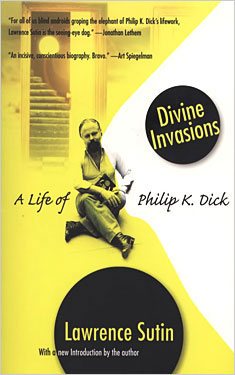 Divine Invasions: A Life of Philip K. Dick
Divine Invasions: A Life of Philip K. Dick
by Lawrence Sutin
My rating: 4 of 5 stars
Answer the following True or False questions about the life of Philip K. Dick:
1) PKD’s twin sister, Jane, died in the first months of her life from malnutrition and poor home care.
2) Later in life, PDK liked to imagine that his sister was living and a lesbian.
3) In high school, PKD’s agoraphobia was at times so bad that he could not go to public events such as concerts. Later he was comfortable in only one Chinese restaurant that had very high sides to its booths.
4) PKD was on amphetamines from the mid 1950’s until around 1972. Some were prescribed, but as the drug scene took off in the 1960’s, he also bought speed off the street.
5) When he was a young man, his mother told him that if he left home he would become a homosexual.
6) PKD’s first wife was also the first woman he had sex with. The marriage lasted six months and Jeanette, the wife, said in court that Phil’s record playing kept her up at night.
7) PKD was married five times, towards the end to women who were barely half his age.
8) Between 1953 and 1957, PKD wrote 14 novels. Between 1963 and 1964 he wrote 11.
9) PKD wrote The Three Stigmata of Palmer Eldritch while tripping on acid.
10) PKD stole pills from his mother and blamed her for not keeping them under lock and key.
11) While trying to live in Canada, PKD felt a mental collapse coming on and pretended to be a heroin addict to get into the only treatment program he could find. He did not like the people he met there.
12) When PKD’s house was broken into, ransacked, and burgled the police were not able to solve the case. They considered PKD to be their most likely suspect.
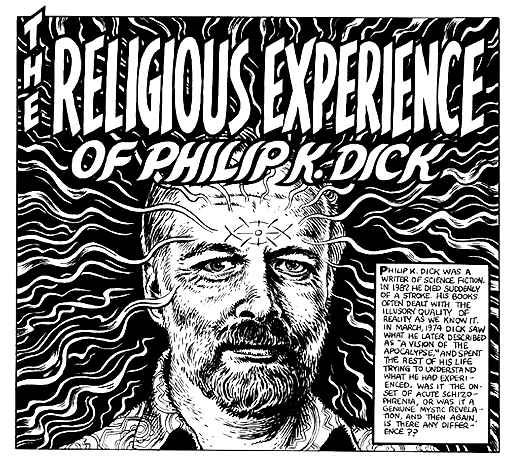 13) When PKD and his wife were investigated by the FBI, his wife fixed dinner for the agents and one agent taught PKD how to drive.
13) When PKD and his wife were investigated by the FBI, his wife fixed dinner for the agents and one agent taught PKD how to drive.
14) In February, 1974, PKD had an impacted wisdom tooth removed and sodium pentathol was used. Later that day, a girl from the drugstore who was delivering Darvon wore an icthus, the Christian fish symbol. When it caught the light, and PKD stared at it, he realized for the first time that he was an immortal being. For the remainder of his life he had visions of the divine and conversations with a divine presence he named VALIS,
15) PKD’s spiritual visions, and many of his other character traits, are common symptoms of temporal lobe epilepsy.
Only number (9) is false. According to his biographer Lawrence Sutin, all the rest are true.
Philip K. Dickathon: Martian Time-Slip
Guest Blogger and WWEnd Member, Charles Dee Mitchell, has contributed a great many book reviews to WWEnd and we’ve invited him to contribute to our blog. This is the latest in Dee’s series of Philip K. Dick reviews that he started on his blog www.potatoweather.blogspot.com. We’ll be posting one every week until he runs out of reviews or gets tired of Philip K. Dick books.
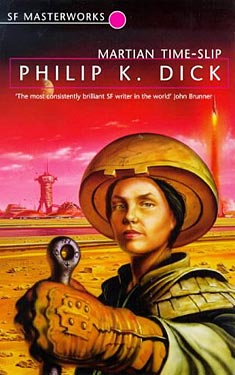 Philip K. Dick just couldn’t be bothered by some of the standard verities of science fiction. He knew SF should often take place in outer space, but whereas other novelists placed their narratives in the 2200’s, 2300’s, or some unimaginable distant future, in the novels Dick wrote in the 1950’s and 1960’s, he thought that 40 or so years was plenty of time for man to start populating the universe. He also didn’t pay much attention to the news coming out from astrophysicists that the weather on other planets seemed to be uniformly bad. Martian Time-Slip takes place in 1994. Mars has scattered settlements and townships, mostly sponsored by national groups from Earth. The exception, and the most powerful group of all, is a Plumbers Union. I assume Dick had had some unpleasantness involving plumbers when he sat down to write this book.
Philip K. Dick just couldn’t be bothered by some of the standard verities of science fiction. He knew SF should often take place in outer space, but whereas other novelists placed their narratives in the 2200’s, 2300’s, or some unimaginable distant future, in the novels Dick wrote in the 1950’s and 1960’s, he thought that 40 or so years was plenty of time for man to start populating the universe. He also didn’t pay much attention to the news coming out from astrophysicists that the weather on other planets seemed to be uniformly bad. Martian Time-Slip takes place in 1994. Mars has scattered settlements and townships, mostly sponsored by national groups from Earth. The exception, and the most powerful group of all, is a Plumbers Union. I assume Dick had had some unpleasantness involving plumbers when he sat down to write this book.
But plumbers are essential to the workings of the settlements. The weather is bearable if a little dry. One good trade-off is that you only weigh about fifty pounds, and housewives slip into halter-tops and Capri pants to visit neighbors. But water is in short supply and closely rationed. Arnie Kott, the vulgarian union boss, is one of the richest and most powerful men on the planet, although that may change. Rumor has it that the U.N. is planning to develop the FDR Mountains, drilling deep water wells and creating self-sustaining luxury living complexes. The land grab is on.
Wikipedia has a coherent synopsis of the book, and I congratulate whoever wrote it. Topics touched on include: schizophrenia (which is almost epidemic), black marketing, adultery, extensive drinking and drug ingestion, pesky neighbors — in other words, it is Dick’s Northern California neighborhood transfered to Mars. Much of the plot hinges on Manfred, an autistic child who becomes a test subject for the main character’s experiments with extrasensory communication and ultimately time travel.
And let’s not forget the Beakmen, the remnants of the Martian race who are now reduced to wandering the deserts or working in the homes of wealthy earthlings. Dick always presents himself as progressive in terms of race and social policies in general, but his portrait of the Beakmen is among his strangest concoctions. Just as he didn’t care much for astrophysics, Dick also didn’t seem to keep up with physical anthropology. The Beakmen are described as "Negroid" and descended from the same source as earthly Africans. (Phil, all homo sapiens come from common stock, long predating any division into races. And so unless you are saying some Central African natives somehow found their way to Mars 30,000 years ago, you are really off on this one.) Also, this is a novel written in the early sixties, and Dick was certainly aware of the Civil Rights movement. So what does it mean that Mars has a society somewhat reflecting the Antebellum South? The word slave is never used, but wealthy settlers have "tame" Beakmen working for them, refer to them as niggers, and enjoy giving them such high-falutin’ names as Heliogabalus. But of course, the Beakmen have deep, secret knowledge. Where was Dick going with this?
This is one of Dick’s enjoyable train wrecks of a novel. I don’t want to slip into biographical criticism, but it reads like a combination of Dick’s marital problems, his extensive experience with psychiatrists, a general dislike of land speculators and plumbers, and some cock-eyed ideas about autism. And as nutty as the whole thing is, the conclusion is not only satisfying on many levels but genuinely strange as well.
Philip K. Dickathon: The Man in the High Castle
Guest Blogger and WWEnd Member, Charles Dee Mitchell, has contributed a great many book reviews to WWEnd and we’ve invited him to contribute to our blog. This is the latest in Dee’s series of Philip K. Dick reviews that he started on his blog www.potatoweather.blogspot.com. We’ll be posting one every week until he runs out of reviews or gets tired of Philip K. Dick books.
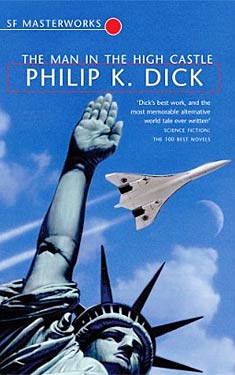 I’ve never been big on Alternate History novels. Never been tempted by those Harry Turtledove books that show spacecraft flying Confederate flags or Doughboys crouching behind armor-plated dinosaurs. But this is Dickian alternative history, and The Man in the High Castle is the novel that won him the Hugo award. He claims in a letter from the mid-sixties that he was not that crazy about this book. Maybe like Henry James he craved success but then tended to look down on works that brought him the most attention. In James’ case it was Washington Square, Daisy Miller, and The Turn of the Screw. And that is the only comparison I would ever think to make between Philip K. Dick and Henry James.
I’ve never been big on Alternate History novels. Never been tempted by those Harry Turtledove books that show spacecraft flying Confederate flags or Doughboys crouching behind armor-plated dinosaurs. But this is Dickian alternative history, and The Man in the High Castle is the novel that won him the Hugo award. He claims in a letter from the mid-sixties that he was not that crazy about this book. Maybe like Henry James he craved success but then tended to look down on works that brought him the most attention. In James’ case it was Washington Square, Daisy Miller, and The Turn of the Screw. And that is the only comparison I would ever think to make between Philip K. Dick and Henry James.
The Allies have lost WWII. The United States is now officially only those states on the Eastern seaboard, and they are under Reich Rule. No one has shown much interest in the Midwest, and, although still part of a conquered empire, it exists as a marginally freer buffer zone. The Japanese control the Pacific States of America, and the bulk of the novel takes place in San Francisco. In the PSA, most Americans have made their peace with the Japanese occupation. No Patrick Swayze has risen to the fore and led a group of teenagers, strangely proficient in advanced military weaponry, to stage a Red Dawn style insurgency. Most San Franciscans are working profitably with, or for, the Japanese, but in alliances that are marked with crippling levels of anxiety. This is, after all, a Philip K. Dick novel.
Dick establishes a dozen or so characters, several of whom are even who they claim to be, and sets things rolling so that paths seemed destined to cross in disastrous ways. But in fact things run rather smoothly with the exception of a couple of spectacular outbreaks of violence. This is a novel of anxiety, not action. It’s a story where anxiety can arise from the excruciating decision of what will be the proper gift to "graft" in a given situation, or by the discovery that the Nazi’s are planning a massive nuclear holocaust. Linked characters are scattered across the continent, and I was worried that somehow everything was going to tie together neatly as in one of the machines-for-winning-Academy-Awards like Crash. But the stories run parallel more often than they cross. One character does save another’s life, but he never meets the man and acts because he is pissed off and wants to exert some authority.
And then there is "the man in the high castle," the reclusive author Hawthorn Abendsen — how does Dick think up these names? Abendsen is the author of the controversial and absurdly titled novel The Grasshoper Lies Heavy. This is an alternative history in which the allies win the war, and although banned by the Nazis, Japanese and American readers are snatching it up. The final question in Dick’s novel centers on the possibility that Abendsen’s novel is not fiction. The Allies did win the war. History is not a progression of events but an infinite play of possibilities. But still a play where some people get killed, some go insane, and some plan to blow the whole thing up.
Philip K. Dickathon: The Cosmic Puppets
Guest Blogger and WWEnd Member, Charles Dee Mitchell, has contributed a great many book reviews to WWEnd and we’ve invited him to contribute to our blog. This is the latest in Dee’s series of Philip K. Dick reviews that he started on his blog www.potatoweather.blogspot.com. We’ll be posting one every week until he runs out of reviews or gets tired of Philip K. Dick books.
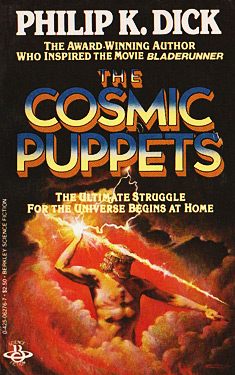 If written today, The Cosmic Puppets could have been Philip K. Dick‘s foray into YA fantasy fiction. He would have needed to change the protagonist into a plucky teenager instead of a full-grown man, but other than that all the elements are in place.
If written today, The Cosmic Puppets could have been Philip K. Dick‘s foray into YA fantasy fiction. He would have needed to change the protagonist into a plucky teenager instead of a full-grown man, but other than that all the elements are in place.
On a road trip to Florida with his almost estranged wife, Ted Barton wants to stop off at Millgate, the Virginian town he left as a young man eighteen years before. They find the town, but everything about it has changed. (Cue the Twilight Zone theme music here.) Street names, buildings, people, everything is different and slightly decrepit. Then Ted finds his name in an old newspaper, a victim of scarlet fever in 1935.
The Cosmic Puppets is pure fantasy — no science fiction involved. There are two children, Peter who makes tiny clay golems to report of Ted’s movements, and Mary who gets regular reports from moths and bees on Peter’s activities. Mary and Peter do not get along. Peter reveals to Ted the enormous beings who make up the valley’s mountainsides and whose heads reach into the heavens. Little Millgate, Virginia, has become the host of an epic battle between the forces of good and evil. (Just their bum luck.) Ted and the town drunk who somehow escaped "the change" have to will the real Millgate back into existence.
There are some creepy elements here, mostly dependent upon how you feel about spiders and rats. But the Twilight Zone theme continues to hum along in the background, and Rod Serling could make an appearance at any moment.
Philip K. Dickathon: Vulcan’s Hammer
Guest Blogger and WWEnd Member, Charles Dee Mitchell, has contributed a great many book reviews to WWEnd and we’ve invited him to contribute to our blog. This is the latest in Dee’s series of Philip K. Dick reviews that he started on his blog www.potatoweather.blogspot.com. We’ll be posting one every week until he runs out of reviews or gets tired of Philip K. Dick books.
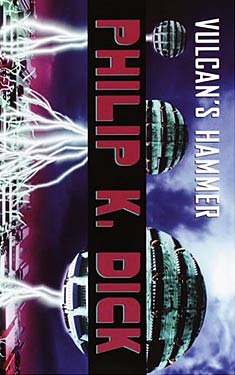 Even Lawrence Sutin, PKD’s biographer, refers to Vulcan’s Hammer as dreck. As per usual for Dick’s novels of this period, there has been a devastating war in the 1970’s, and this time around humanity’s bad idea for how to handle post-war society it to turn everything over to computers. These machines’ decisions will be based purely on logic, war will come to an end, but of course an elaborate police system must be put into place to maintain this logical utopia. Underground movements are breaking out across the globe.
Even Lawrence Sutin, PKD’s biographer, refers to Vulcan’s Hammer as dreck. As per usual for Dick’s novels of this period, there has been a devastating war in the 1970’s, and this time around humanity’s bad idea for how to handle post-war society it to turn everything over to computers. These machines’ decisions will be based purely on logic, war will come to an end, but of course an elaborate police system must be put into place to maintain this logical utopia. Underground movements are breaking out across the globe.
The computer has had three incarnations, Vulcan I, Vulcan II, and the current Vulcan III that only one man can access in its impregnable stronghold deep underground in Switzerland. The current director maintains a fondness for dusty old Vulcan II. He enjoys making the punch cards that feed it information and then reading the printouts it releases, although those messages now take up to a day or so to appear. There’s something a little creepy about Vulcan III with its digital screens and its suspicion that its humans are not telling it the whole story. Of course, Vulcan III decides to take matters into its own hands.
Dick’s novel has all the pieces in place but then has nowhere to go with them. The conclusion is as predictable as it is anti-climactic. Vulcan’s Hammer was the "B side" of an Ace Double, so it has if nothing else the virtue of brevity.
Philip K. Dickathon: Dr. Futurity
Guest Blogger and WWEnd Member, Charles Dee Mitchell, has contributed a great many book reviews to WWEnd and we’ve invited him to contribute to our blog. This is the latest in Dee’s series of Philip K. Dick reviews that he started on his blog www.potatoweather.blogspot.com. We’ll be posting one every week until he runs out of reviews or gets tired of Philip K. Dick books.
 I hope Phil was able to pay some bills with whatever money he got from Dr. Futurity. It is filled with the kind of prose that sounds like the author is thinking through what his character might do next, making notes rather than telling a story.
I hope Phil was able to pay some bills with whatever money he got from Dr. Futurity. It is filled with the kind of prose that sounds like the author is thinking through what his character might do next, making notes rather than telling a story.
This one is definitely for completists only.
Philip K. Dickathon: Time Out of Joint
Guest Blogger and WWEnd Member, Charles Dee Mitchell, has contributed a great many book reviews to WWEnd and we’ve invited him to contribute to our blog. This is the latest in Dee’s series of Philip K. Dick reviews that he started on his blog www.potatoweather.blogspot.com. We’ll be posting one every week until he runs out of reviews or gets tired of Philip K. Dick books.
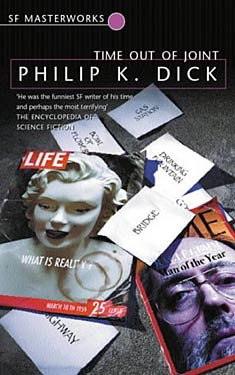 Throughout the 1950’s, Philip K. Dick continued to write mainstream novels involving working class characters and realistic situations. His agents were never able to place any of these titles with publishers, at least not until several years after Dick’s death when the Dickian industry began in earnest and publishers were scrounging for new material. Dick sometimes disparaged his sf output, but he continued to have faith in these realist novels into the 1960’s.
Throughout the 1950’s, Philip K. Dick continued to write mainstream novels involving working class characters and realistic situations. His agents were never able to place any of these titles with publishers, at least not until several years after Dick’s death when the Dickian industry began in earnest and publishers were scrounging for new material. Dick sometimes disparaged his sf output, but he continued to have faith in these realist novels into the 1960’s.
Time out of Joint, published in 1959, is a science fiction story that reads, for much of the time, as one of Dick’s mainstream efforts. The characters are middle management types, one manages the produce department of a local grocery store, another works for the water department. They live in a new suburb of modest homes and are somewhat civically active. One couple, Vic and Margo, share their home with Margo’s brother, Raigle, a war veteran who makes a comfortable living by answering a daily newspaper quiz, Where Will the Little Green Man Land Next. He is always right and has become something of a celebrity.
The first odd moment arrives when Vic looks through a newly arrived brochure from the Book-of-the-Month Club and wonders who Harriet Beecher Stowe might be. It’s possible he wouldn’t know, but later Raigle sees a layout in Life Magazine and marvels that the featured starlet’s breasts can maintain the tilt they have in the photographs. Since this is a Philip K. Dick novel, all three characters analyze the breasts in some detail but then also wonder among themselves just who Marilyn Monroe could be that she would merit so much attention.
The next day, while Raigle contemplates adultery with the neighbor’s wife, he takes her to the municipal swimming pool, and when he goes to the refreshment stand for cokes, the stand and its manager fade from sight leaving behind only a piece of paper with the printed words SOFT-DRINK STAND. Raigle puts the note into a box he keeps in his pocket where similar messages read DOOR, FACTORY BUILDING, BOWL OF FLOWERS.
We are now in Dickian territory, where few people are who they claim to be, and a trip past the city limits is a trip to another world. Dick earns his standing as the connoisseur of American paranoia with this one. Early on Raigle has the insight that he may be the most important person in the world. He’s no dummy.
Philip K. Dickathon: The World Jones Made
Guest Blogger and WWEnd Member, Charles Dee Mitchell, has contributed a great many book reviews to WWEnd and we’ve invited him to contribute to our blog. This is the latest in Dee’s series of Philip K. Dick reviews that he started on his blog www.potatoweather.blogspot.com. We’ll be posting one every week until he runs out of reviews or gets tired of Philip K. Dick books.
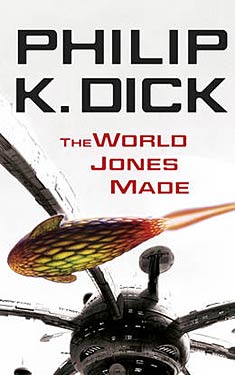 Philip K. Dick published The World Jones Made in 1956 and didn’t give "life as we know it" much time. A devastating world war breaks out in the 1970’s, but humankind proves remarkably resilient. By the mid 1990’s, when the story begins, we are already zipping around town in airborne taxis and traveling cross country in the matter of an hour or so. You may live in Detroit but you party in San Francisco. "Relativity" is the accepted philosophy of the day, and I found it one of Dick’s vaguer concepts. People can not only do most anything they want, but they must let others do so as well, and they cannot, under any circumstances, express a belief in anything. This live and let live code must be enforced by an elaborate security police force, and Cussick, the central character, is on the force.
Philip K. Dick published The World Jones Made in 1956 and didn’t give "life as we know it" much time. A devastating world war breaks out in the 1970’s, but humankind proves remarkably resilient. By the mid 1990’s, when the story begins, we are already zipping around town in airborne taxis and traveling cross country in the matter of an hour or so. You may live in Detroit but you party in San Francisco. "Relativity" is the accepted philosophy of the day, and I found it one of Dick’s vaguer concepts. People can not only do most anything they want, but they must let others do so as well, and they cannot, under any circumstances, express a belief in anything. This live and let live code must be enforced by an elaborate security police force, and Cussick, the central character, is on the force.
Jones threatens this world because he is a prophet, able to see into the future for up to one year. This means that the future is known, it is a sure thing, and so the Relativity world will fall apart. The mob longs for Jones’s message and forms a devoted following that transforms into a worldwide movement. He can’t be stopped because he already knows every move that will be made against him. Cussick’s gorgeous Scandinavian wife aligns herself with the Jones movement and becomes a senior officer in the organization. There is a subplot concerning human mutants specially bred to survive on Venus, and an inconvenient but not very dangerous invasion of giant space amoebas that the Jones followers raucously destroy.
All of this does not make into a very coherent novel, and, for as nutty as much of it is, The World Jones Made is a little downbeat for Dick. The characters, other than Jones, are exhausted and justifiably pessimistic, caught up in defending a world order they know is doomed and which they no longer really believe in. No wonder they go to night clubs and make concoctions of heroin and marijuana their first drink of the night.



















 Full Details
Full Details

